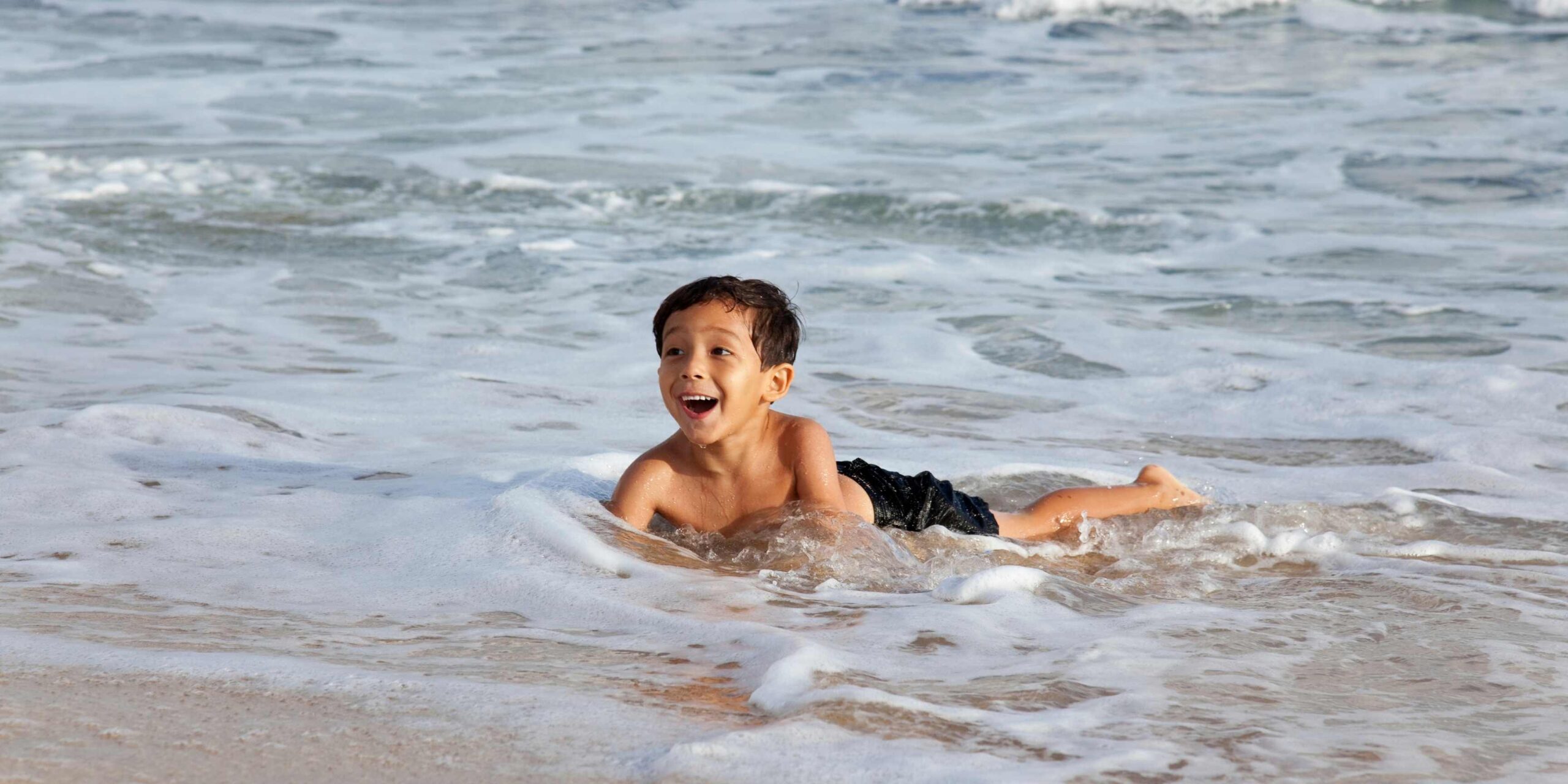This post may contain affiliate links. We may earn money from products we link to in this post.
Skimboarding is a fun, sporty, and inexpensive way to keep your children amused while at the beach. Skimboarding is becoming increasingly popular, and for good reason. It’s a safe way to introduce your children to the water, test their abilities, build their confidence, and have fun!
Kids Love to Skimboard
Going to the beach as a parent is nothing like it used to be, when all you needed was a towel and a good book.
A trip to the beach now entails dragging shovels, buckets, towels, sunscreen, chairs, food, water bottles, an umbrella, and other items through the hot sand. When you come to the beach, your kids are either scared of the sea and the noisy waves pounding on the coast, or they are so interested that they can’t stay out of them!
And in the latter situation, perhaps it’s you who is concerned about sending them into the unknown.
In any case, if you want to find a happy medium where your kids may play in the water while not being too far out in the ocean, a skimboard is the answer.
Skimboarding is a terrific method for youngsters to stay close to the shore while still having fun in shallow water.
What is skimboarding
Skimboarding is a water activity comparable to surfing in which you use a small flat board to skid or slide across the surface of the water near to the shore.
Skimboards are much smaller and thinner than surfboards and lack fins. Skimboarding takes place in shallow water along the ocean’s edge, so there’s no need to walk out into the water and wait for a wave like surfing.
Teaching Your Child to Skimboard
The most common method of skimboarding is to glide across a thin layer of water with the board parallel to the waves. This is the most effective approach for children to learn to skimboard. Skimboarding is quite simple to learn and master on your own, but if you’re serious about it, many surf shops provide group and private classes, as well as skim camps.
The following are the steps of gliding skimboarding:
- Place yourself in shallow water with at least a few inches of water between the surface and the ground.
- Hold the skimboard in both hands, with your dominant hand on the board’s base (bottom) and your other hand on the board’s top.
- Take a few steps and swing the board parallel to the surface of the water, then release it in front of you. The board should skim across the water’s surface. (Imagine skipping a huge rock on the water with two hands.)
- Throw the board hard enough that it moves and doesn’t lose momentum when you walk on it, but not so hard that you can’t immediately climb on after a few steps. This takes a lot of practice to master.
- Step onto the board with your non-dominant foot in front and your dominant foot in back after taking a few running steps behind it. You should take a gentle stride into the skimboard rather than jumping on top of it (which will sink the board and kill the momentum). It’s like slipping on wooden floors while wearing socks.
Skimboarding In Deep Water
The more advanced technique is to skimboard into deeper water and right into approaching waves. This form of skimboard wave riding is ideal for older children.
You employ the same approach as described previously, but this time you point the nose of the skimboard into the water.
We’ve seen advanced and professional skimboarders perform a variety of spins, flips, and tricks this way. It’s definitely something to strive for!
When Your Child Falls Off The Skimboard
When your children are first learning to skimboard, it’s crucial to let them know that they will tumble down. Spills and falls occur. A lot.
When you try to get onto the skimboard, it frequently pulls your feet out from under you, leaving you flat on your back in the water.
Expect some falls and prepare your children not only for the crash (in the sand), but also for the possibility of water and sand getting into their mouth, eyes, and nostrils. It might be frightening for children the first few times it occurs.
The advantage of falling off a skimboard over skateboarding is that the fall will not be on a harsh concrete surface. Wet sand is much softer than concrete, but it can still be painful. However, falling down is a crucial part of life in general, so applaud the fact that they continue to try even when things get difficult.
Benefits Of Skimboarding
Skimboarding provides numerous health benefits for children (and even adults)! Some of the advantages of skimboarding are as follows:
- improved balance
- improved core strength and coordination
- increased understanding of ocean/wave patterns
- Vitamin D exposure
- Running on the uneven sand surface strengthens the tiny muscles in the feet.
Reasons To Let your child Try Skimboarding
Skimboard Size Is Manageable For Kids
A skimboard is compact and portable. Have you ever attempted to transport a surfboard from your car to the waves? It is not simple! Surfboards are enormous and heavy (and expensive).
When carrying, I have to constantly modify the surfboard to obtain a comfortable position.
Skimboards, on the other hand, are significantly easier for parents (and kids) to transport to the beach. A smaller board also requires less storage space and is less expensive.
It Helps Get Kids More comfortable With The Ocean
Skimboarding is an excellent introduction to the ocean for any children (or parents) who are afraid of surfing or swimming in the waves. Skimboarding is an excellent introduction for anyone who is unfamiliar with waves and surf. It will help your child (and you) become more comfortable in the water and confidence in their abilities.
Skimboarding allows you to stay close to the water’s edge. You may acquire a sense of the ocean without really entering it. Skimboarding is an excellent way for your children to learn about the waves and how they break while remaining able to touch the ground and stay near to the shore.
It Can Be Done In All Weather
Skimboarding, unlike surfing or swimming, does not require you to immerse yourself in water.
On a cold day, you can skimboard without being entirely soaked or frozen. You can skimboard without getting wet once you get the hang of it. My kids have even gone skimboarding while dressed in sweatpants!
I wouldn’t necessarily encourage it, but it is possible. Our West Coast beaches can get frigid in the fall and winter, but we can often skimboard in the off-season.
Skimboarding Is Fun For All Ages
Skimboarding is ideal for children aged 6 and up. The fundamental principles are simple to learn, and you don’t need to be a good swimmer to skimboard.
Skimboarding does not require going very far into the water, thus it is an activity that children can enjoy before becoming excellent swimmers.
We always recommend a life jacket or other floating equipment, as well as close parental monitoring, for any youngster who cannot swim who is playing near water.

